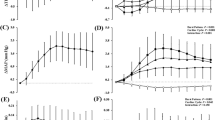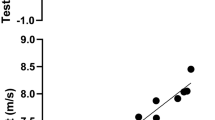Abstract
Cardiovascular autonomic function is associated with physical performance and exercise training adaptation. The association between physical performance and sympathetic regulation is not well known. We hypothesized that sympathetic nervous system activity is associated with physical performance among male runners. The study population included 26 healthy male club runners [age 33 ± 5 years, body mass index (BMI) 24 ± 1 kg/m2, VO2max 58 ± 5 ml kg−1 min−1; mean ± SD]. Muscle sympathetic nerve activity (MSNA) was assessed from the peroneal nerve by the microneurography technique during 5 min of supine rest. Physical performance was assessed by time to exhaustion during treadmill running. The mean resting MSNA was 20 ± 6 bursts min−1 (range 6–34). The mean time to exhaustion was 1,005 ± 136 s (range 720–1260). When the study group was divided into tertiles according to their running performance (866 ± 69, 994 ± 30 and 1154 ± 71 s in time to exhaustion, P < 0.0001 between the groups), MSNA was lower (P = 0.032) in the group with the best running performance (16 ± 5 bursts min−1) compared to those with the worst running performance (23 ± 7 bursts min−1). In conclusion, baseline sympathetic activity, measured by a microneurography at rest, may be associated with the maximal running performance of healthy subjects.


Similar content being viewed by others
References
Alvarez GE, Halliwill JR, Ballard TP, Beske SD, Davy KP (2005) Sympathetic neural regulation in endurance-trained humans: fitness vs. fatness. J Appl Physiol 98:498–502
Charkoudian N, Joyner MJ, Johnson CP, Eisenach JH, Dietz NM, Wallin BG (2005) Balance between cardiac output and sympathetic nerve activity in resting humans: role in arterial pressure regulation. J Physiol 568:315–321
Charkoudian N, Joyner MJ, Sokolnicki LA, Johnson C, Eisenach J, Dietz N, Curry T, Wallin BG (2006) Vascular adrenergic responsiveness is inversely related to tonic activity of sympathetic vasoconstrictor nerves in humans. J Physiol 572:821–827
de Boer RW, Karemaker JM, Strackee J (1985) Relationships between short-term blood-pressure fluctuations and heart-rate variability in resting subjects. I: a spectral analysis approach. Med Biol Eng Comput 23:352–358
Goldsmith RL, Bigger JT Jr, Bloomfield DM, Steinman RC (1997) Physical fitness as a determinant of vagal modulation. Med Sci Sports Exerc 29:812–817
Grassi G, Seravalle G, Calhoun DA, Mancia G (1994) Physical training and baroreceptor control of sympathetic nerve activity in humans. Hypertension 23:294–301
Hautala AJ, Makikallio TH, Kiviniemi A, Laukkanen RT, Nissila S, Huikuri HV, Tulppo MP (2003) Cardiovascular autonomic function correlates with the response to aerobic training in healthy sedentary subjects. Am J Physiol Heart Circ Physiol 285:H1747–H1752
Hautala AJ, Makikallio TH, Kiviniemi A, Laukkanen RT, Nissila S, Huikuri HV, Tulppo MP (2004) Heart rate dynamics after controlled training followed by a home-based exercise program. Eur J Appl Physiol 92:289–297
Howley ET, Bassett DR Jr, Welch HG (1995) Criteria for maximal oxygen uptake: review and commentary. Med Sci Sports Exerc 27:1292–1301
Kiviniemi AM, Hautala AJ, Seppanen T, Makikallio TH, Huikuri HV, Tulppo MP (2004) Saturation of high-frequency oscillations of R–R intervals in healthy subjects and patients after acute myocardial infarction during ambulatory conditions. Am J Physiol Heart Circ Physiol 287:H1921–H1927
Kiviniemi AM, Hautala AJ, Makikallio TH, Seppanen T, Huikuri HV, Tulppo MP (2006) Cardiac vagal outflow after aerobic training by analysis of high-frequency oscillation of the R-R interval. Eur J Appl Physiol 96:686–692
Levy WC, Cerqueira MD, Harp GD, Johannessen KA, Abrass IB, Schwartz RS, Stratton JR (1998) Effect of endurance exercise training on heart rate variability at rest in healthy young and older men. Am J Cardiol 82:1236–1241
Ng AV, Callister R, Johnson DG, Seals DR (1994) Endurance exercise training is associated with elevated basal sympathetic nerve activity in healthy older humans. J Appl Physiol 77:1366–1374
Noakes TD (1988) Implications of exercise testing for prediction of athletic performance: a contemporary perspective. Med Sci Sports Exerc 20:319–330
Noakes TD, Myburgh KH, Schall R (1990) Peak treadmill running velocity during the VO2 max test predicts running performance. J Sports Sci 8:35–45
Paavolainen L, Hakkinen K, Hamalainen I, Nummela A, Rusko H (1999) Explosive-strength training improves 5-km running time by improving running economy and muscle power. J Appl Physiol 86:1527–1533
Pagani M, Somers V, Furlan R, Dell’Orto S, Conway J, Baselli G, Cerutti S, Sleight P, Malliani A (1988) Changes in autonomic regulation induced by physical training in mild hypertension. Hypertension 12:600–610
Ray CA (1999) Sympathetic adaptations to one-legged training. J Appl Physiol 86:1583–1587
Robinson BF, Epstein SE, Beiser GD, Braunwald E (1966) Control of heart rate by the autonomic nervous system. Studies in man on the interrelation between baroreceptor mechanisms and exercise. Circ Res 19:400–411
Rosenblueth A, Simeone FA (1934) The interactions of vagal and accelerator effect on cardiac rate. Am J Physiol 110:42–55
Seals DR (1991) Sympathetic neural adjustments to stress in physically trained and untrained humans. Hypertension 17:36–43
Sheldahl LM, Ebert TJ, Cox B, Tristani FE (1994) Effect of aerobic training on baroreflex regulation of cardiac and sympathetic function. J Appl Physiol 76:158–165
Shoemaker JK, Hogeman CS, Khan M, Kimmerly DS, Sinoway LI (2001) Gender affects sympathetic and hemodynamic response to postural stress. Am J Physiol Heart Circ Physiol 281:H2028–H2035
Sinoway LI, Rea RF, Mosher TJ, Smith MB, Mark AL (1992) Hydrogen ion concentration is not the sole determinant of muscle metaboreceptor responses in humans. J Clin Invest 89:1875–1884
St Clair Gibson A, Noakes TD (2004) Evidence for complex system integration and dynamic neural regulation of skeletal muscle recruitment during exercise in humans. Br J Sports Med 38:797–806
Svedenhag J, Wallin BG, Sundlof G, Henriksson J (1984) Skeletal muscle sympathetic activity at rest in trained and untrained subjects. Acta Physiol Scand 120:499–504
Tulppo MP, Makikallio TH, Takala TE, Seppanen T, Huikuri HV (1996) Quantitative beat-to-beat analysis of heart rate dynamics during exercise. Am J Physiol 271:H244–252
Tulppo MP, Makikallio TH, Seppanen T, Laukkanen RT, Huikuri HV (1998) Vagal modulation of heart rate during exercise: effects of age and physical fitness. Am J Physiol 274:H424–429
Tulppo MP, Hautala AJ, Makikallio TH, Laukkanen RT, Nissila S, Hughson RL, Huikuri HV (2003) Effects of aerobic training on heart rate dynamics in sedentary subjects. J Appl Physiol 95:364–372
Tulppo MP, Huikuri HV, Tutungi E, Kimmerly DS, Gelb AW, Hughson RL, Makikallio TH, Shoemaker JK (2005) Feedback effects of circulating norepinephrine on sympathetic outflow in healthy subjects. Am J Physiol Heart Circ Physiol 288:H710–H715
Vallbo AB, Hagbarth KE, Torebjork HE, Wallin BG (1979) Somatosensory, proprioceptive, and sympathetic activity in human peripheral nerves. Physiol Rev 59:919–957
Wallin BG, Charkoudian N (2007) Sympathetic neural control of integrated cardiovascular function: Insights from measurement of human sympathetic nerve activity. Muscle Nerve 36:595–614
Acknowledgments
This research was funded by grants from the Ministry of Education (Helsinki, Finland) and Finnish Funding Agency for Technology and Innovation, TEKES (Helsinki, Finland).
Author information
Authors and Affiliations
Corresponding author
Rights and permissions
About this article
Cite this article
Hautala, A.J., Kiviniemi, A.M., Mäkikallio, T.H. et al. Muscle sympathetic nerve activity at rest compared to exercise tolerance. Eur J Appl Physiol 102, 533–538 (2008). https://doi.org/10.1007/s00421-007-0618-1
Accepted:
Published:
Issue Date:
DOI: https://doi.org/10.1007/s00421-007-0618-1




